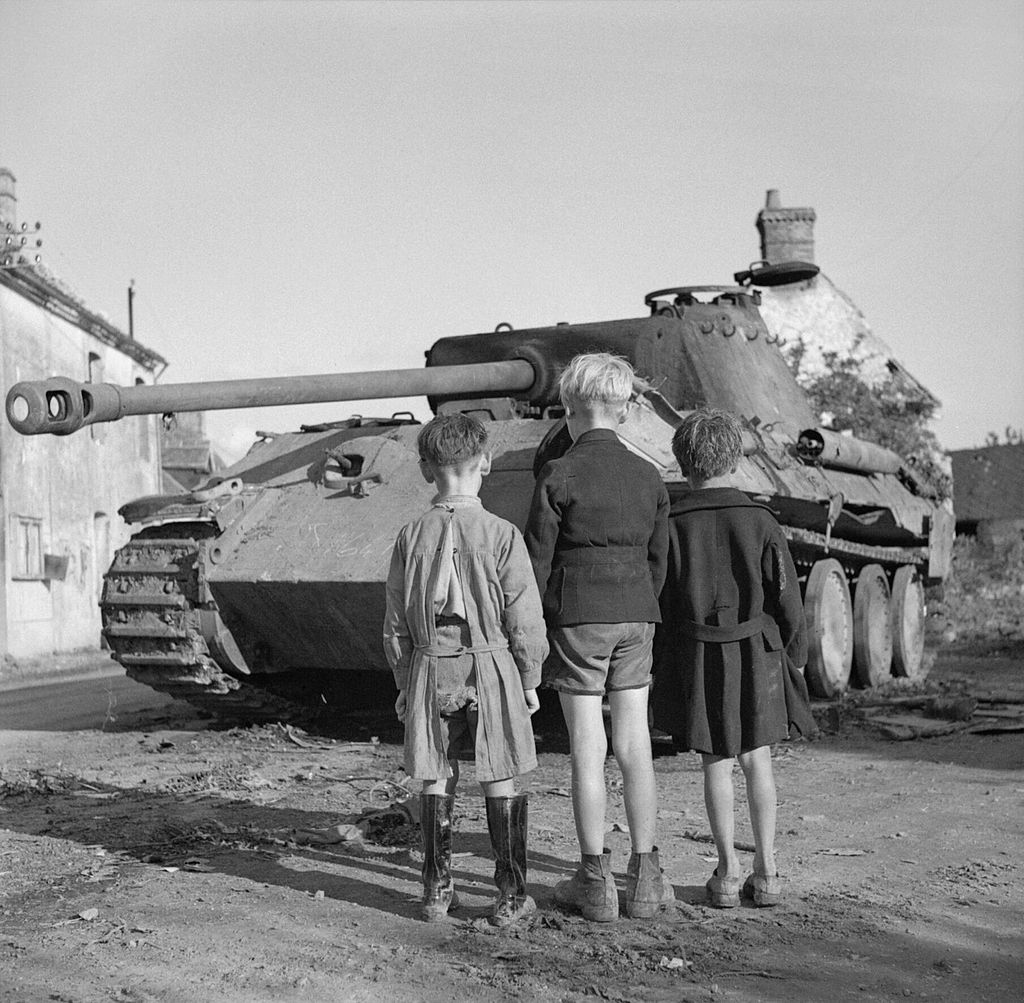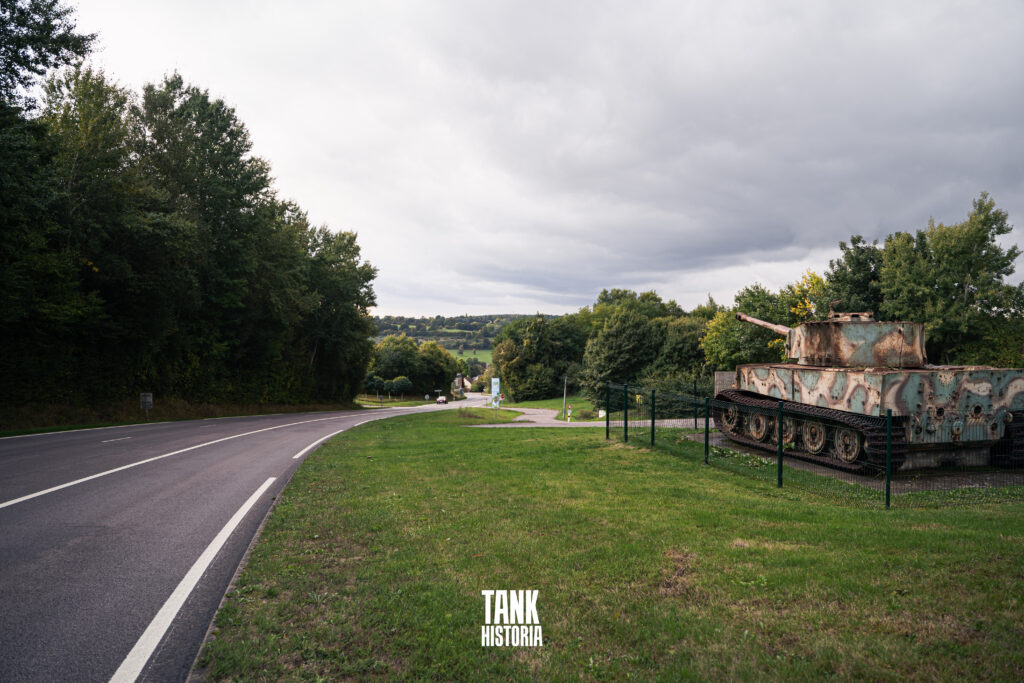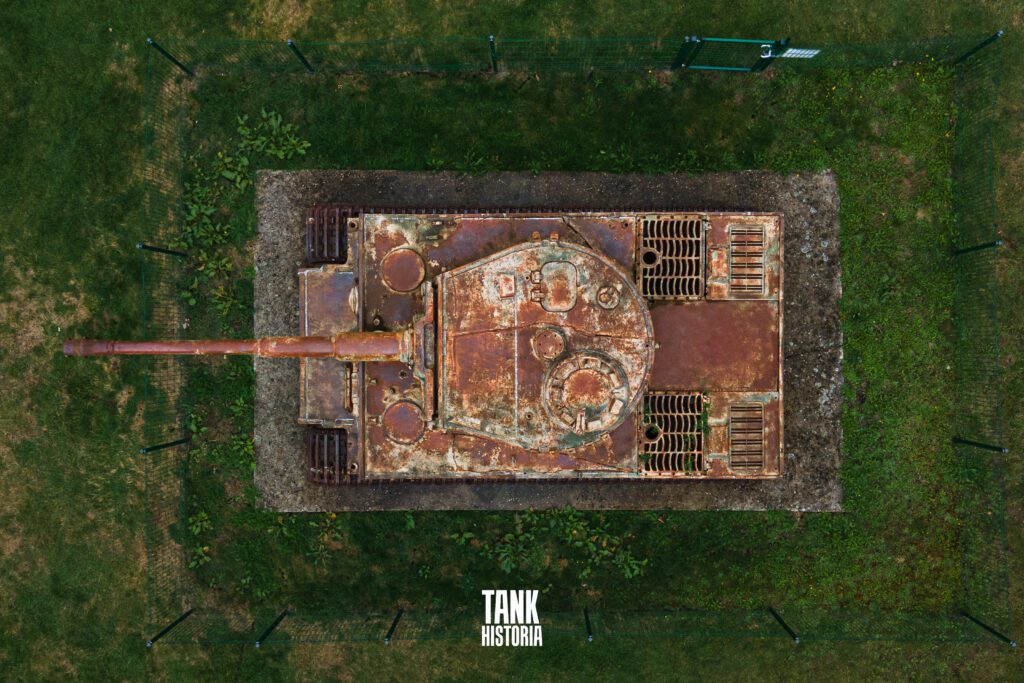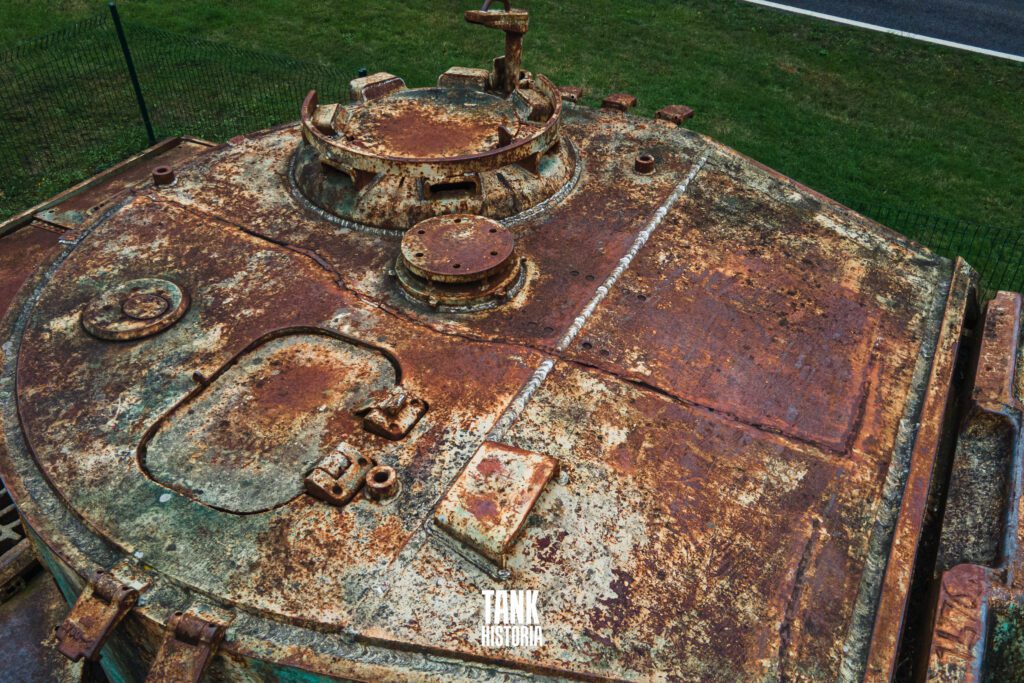
Vimoutiers Tiger – Left in a Hedge for 30 Years
During a visit to Normandy, France, we made a 2 hour trip to visit a single Second World War tank in the Orne Department of the country. While tanks are far from a rare sight in Normandy, this one was particularly special: it was a Tiger!
Known as the “Vimoutiers Tiger” after the nearby town, this vehicle is special for the simple fact that it is a Tiger – one of only around 10 in existence.
But the Vimoutiers Tiger stands out even among those, as it is one of only two Tigers that can be seen in the wild anywhere on the planet. No museum admissions or payments needed here, this tank is quite literally sat out in the open for all to see.
 The Vimoutiers Tiger was registered as a Historic Monument in 1975.
The Vimoutiers Tiger was registered as a Historic Monument in 1975.
It is situated beside a road, overlooking the town of Vimoutiers and is one of the area’s most significant attractions. However, its unique situation is also its biggest enemy, as it has fallen victim to looting and the elements.
Visiting the Vimoutiers Tiger
The real life impact of the infamous Tiger is often overstated, but as a life-long enthusiast of all things tanks, the Tiger has always had a certain aura that few other vehicles can match.
After many trips to Normandy over the years, the Vimoutiers Tiger has so far evaded my efforts to see it, usually because of a lack of time. This year though that finally changed, and I can now consider this tank ticked off my list.
 An aerial view of the Vimoutiers Tiger.
An aerial view of the Vimoutiers Tiger.
One of our main reasons for the trip was to photograph tanks, so the two hour drive from our Gîte near Sainte-Mère-Église to the Tiger was more than worth it!
This Tiger’s Story
The Vimoutiers Tiger is a Tiger Ausf. E, number 231 and was involved in actions around the infamous Falaise pocket.
After heavy fighting in the weeks after the D-Day landings, German troops were progressively pushed back by overwhelming Allied forces. In trying to stop this advance, German forces used up massive amounts of resources, accelerated by relentless Allied air attacks on supply lines. By August the Allies had formed a pocket around German Army Group B in the Falaise area of the Calvados Department of Normandy.
 French children looking at a German Panther knocked out in the Falaise pocket.
French children looking at a German Panther knocked out in the Falaise pocket.
The pocket was closed on August 21, 1944, trapping around 50,000 German troops inside. This action concluded the Battle of Normandy.
Vimoutiers was located near the mouth of the pocket.
On August 19, the Vimoutiers Tiger was heading south east out of the pocket, likely on its way to a fuel dump in Ticheville. However, just a short distance outside of Vimoutiers the Tiger ran out of fuel.
 The Vimoutiers commune is located at the bottom of this road, a short distance from the where the Tiger ran out of fuel.
The Vimoutiers commune is located at the bottom of this road, a short distance from the where the Tiger ran out of fuel.
With the encirclement closing, the crew abandoned the tank and placed demolition charges inside to sabotage it. The subsequent explosion caused significant damage, cracking and lifting the hull roof armor around the turret.
Its torsion bar suspension appears to have been shattered in the blast too.
When the Allies arrived, the tank was bulldozed off the road to clear the way.
 The Vimoutiers Tiger in its position on the side of the road.
The Vimoutiers Tiger in its position on the side of the road.
And that is where this Tiger remained for the next 31 years, sitting ominously in a ditch by the roadside.
After the war it was purchased by scrap dealer M. Morat, and should have been cut up in the post-war scrapping drives happening across the country. However the 60 ton tank proved to much to tackle, so Morat removed what he could and left the vehicle in place.
Ownership of the Tiger transferred to Morat’s sister upon his death, who then sold it to a scrapping company in Caen.
 The tank shows signs of previous scrapping attempts, such as this cut line made by a gas torch.
The tank shows signs of previous scrapping attempts, such as this cut line made by a gas torch.
However by this time the Tiger had become something of a local monument, so when news of its planned removal reached the residents of Vimoutiers there was a sudden rush to save it.
The town raised funds and purchased the Tiger in the 1970s. In 1975 it was pulled out of its ditch and placed on a concrete pad nearby, in a commanding position overlooking the town. It was also painted in an inaccurate color scheme. This is how it still remains today.
 The Vimoutiers Tiger on its concrete pad.
The Vimoutiers Tiger on its concrete pad.
Current Condition
After making our way through the wide and forested landscapes of central Normandy, the Vimoutiers Tiger revealed itself ahead of us as we left the town and travelled up the same road it once took in 1944.
Its poor condition was immediately noticeable. It has remained outside for nearly 80 years, and time hasn’t been kind.
For almost all of that time it was not fenced off, so many parts have been removed by those eager to take home a piece of Tiger tank. Nearly everything that isn’t welded down is now missing.
 This Tiger has a “naked” appearance, as almost everything that can be removed has been removed.
This Tiger has a “naked” appearance, as almost everything that can be removed has been removed.
In 2018 a chest-height fence was erected around the tank in a bid to keep visitors from climbing on it, but the fence’s buckled and dented appearance suggests this hasn’t entirely worked.
Something the fence does actually prevent though is good photographs, obscuring half the vehicle. Luckily we came armed with a drone, giving us a unique perspective of the Tiger.
It is a late model example, indicated by its steel-rimmed wheels, low-profile, cast commanders cupola and small muzzle brake.
 A unique bird’s-eye view of the Vimoutiers Tiger.
A unique bird’s-eye view of the Vimoutiers Tiger.
The Vimoutiers Tiger does not sit on its tracks, instead, its belly is placed on a concrete slab that supports its weight.
On both sides of the turret front, near the gun mantlet, is large vertical cuts in the armor, running top to bottom. These appear to have been made by a gas axe. Another cut runs down the center of the turret roof (now partially filled with weld), and continues down the back of the turret.
 Gas torch marks in the turret roof and rear. It appears there was once an attempt to cut the 80 mm thick turret side armor into two pieces.
Gas torch marks in the turret roof and rear. It appears there was once an attempt to cut the 80 mm thick turret side armor into two pieces.
The hull plates are in relatively good condition – aside from a few engraved names made by visitors. The hull roof is a different matter though, with large cracks in the sections around the turret bulging upwards.
All hatches have been covered by thin plates to prevent access inside.
 The large crack in hull roof on the left side of the tank caused by the internal explosion. Similar damage is present on the other side.
The large crack in hull roof on the left side of the tank caused by the internal explosion. Similar damage is present on the other side.
The engine deck is in equally poor condition. The rear radiator covers have been replaced with what appears to be engine decking from a Panzer IV. The rear is devoid of nearly every fitting, including the exhausts and their armored shrouds.
 The engine deck and rear of the Vimoutiers Tiger. The forward grills are actually Tiger components.
The engine deck and rear of the Vimoutiers Tiger. The forward grills are actually Tiger components.
The upside of its naked condition is that now only the armor remains, which is not going anywhere for a long time yet.
The Tiger’s Future
As one of just a handful of Tigers left on the planet, you’d expect good news for the future of this tank. Unfortunately this isn’t likely. Since around 2013 there has been an ongoing effort to protect and even restore this tank, with various levels of restoration having been discussed.
Recent plans aim to relocate the Tiger into Vimoutiers to bring more visitors into the town, but so far this has not happened. Restoring the tank into running order, or even just the interior, would be an almost impossible task due to deterioration and massive list of missing parts.
 The turret roof, showing the plated over hatches and gas torch cut marks. The cost of repairing the damage and replacing missing parts would be extremely high.
The turret roof, showing the plated over hatches and gas torch cut marks. The cost of repairing the damage and replacing missing parts would be extremely high.
The most feasible, and therefore likely option is to give the tank a basic exterior restoration and prevent further decay.
The Association for the Restoration of the Vimoutiers Tiger Tank in Normandy was set up to handle restoration-related activities. The president of this committee, Olivier Robert, estimates the Tiger’s value at around 4-5 million Euros (3.9-4.9 million Dollars) even in its poor state.
Finding the Vimoutiers Tiger
The Tiger is situated just outside the town of Vimoutiers, on the D979 road heading south-east to Ticheville. Vimoutiers is quite small, so simply follow the D979 south out the town and you will see the Tiger on an incline just minutes up the road.
Its exact coordinates are – 48.923701, 0.214921.
The tank is listed in its correct location on Google Maps as “Tiger Tank”.
 The Vimoutiers Tiger is positioned next to the D979 road that runs through Vimoutiers.
The Vimoutiers Tiger is positioned next to the D979 road that runs through Vimoutiers.
The town of Vimoutiers itself is about an hour drive from Caen, and around 2 hours from the Sainte-Mère-Église/Carentan area. Much of the drive from this region consists of dual carriageways, but you will pass through Falaise itself and Trun on the way.
The town of Camembert, the home of camembert cheese, is just a few miles away from Vimoutiers.
If you are in the area, or even a few hours away, and have any sort of appreciation for tanks this is not one to miss. The sheer fact that it is a Tiger makes it worth it, but the possibility of seeing a German big cat in the wild makes it a must-see for tank enthusiasts.
News
The Hanging Temple: China’s 1,500-Year-Old Cliffside Marvel of Faith and Engineering
The Hanging Temple: China’s 1,500-Year-Old Cliffside Marvel of Faith and Engineering Perched precariously on the cliffs of Mount Heng in Shanxi Province, China, the Hanging Temple, also known as Xuankong Temple, Hengshan Hanging Temple, or Hanging Monastery, is an architectural…
The Willendorf Venus: A 30,000-Year-Old Masterpiece Reveals Astonishing Secrets
The Willendorf Venus: A 30,000-Year-Old Masterpiece Reveals Astonishing Secrets The “Willendorf Venus” stands as one of the most revered archaeological treasures from the Upper Paleolithic era. Discovered in 1908 by scientist Johann Veran near Willendorf, Austria, this small yet profound…
Unveiling the Maya: Hallucinogens and Rituals Beneath the Yucatán Ball Courts
Unveiling the Maya: Hallucinogens and Rituals Beneath the Yucatán Ball Courts New archaeological research has uncovered intriguing insights into the ritual practices of the ancient Maya civilization. The focus of this study is a ceremonial offering found beneath the sediment…
Uncovering the Oldest Agricultural Machine: The Threshing Sledge’s Neolithic Origins
Uncovering the Oldest Agricultural Machine: The Threshing Sledge’s Neolithic Origins The history of agricultural innovation is a fascinating journey that spans thousands of years, and one of the earliest known agricultural machines is the threshing sledge. Recently, a groundbreaking study…
Nara’s Ancient Sword: A 1,600-Year-Old Protector Against Evil Spirits
Nara’s Ancient Sword: A 1,600-Year-Old Protector Against Evil Spirits In a remarkable discovery that has captured the attention of archaeologists and historians alike, a 7.5-foot-long iron sword was unearthed from a 1,600-year-old burial mound in Nara, Japan. This oversized weapon,…
The Inflatable Plane, Dropped Behind the Lines for Downed Pilots
Experimental The Inflatable Plane, Dropped Behind the Lines for Downed Pilots The Inflatoplane from Goodyear was an unconventional aircraft developed by the Goodyear Aircraft Company, a branch of the renowned Goodyear Tire and Rubber Company, also famed for the Goodyear…
End of content
No more pages to load











